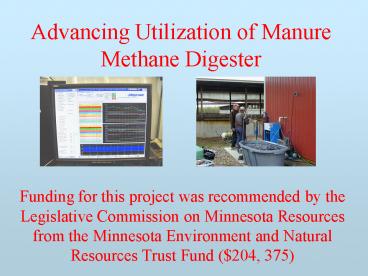Advancing Utilization of Manure Methane Digester - PowerPoint PPT Presentation
1 / 20
Title:
Advancing Utilization of Manure Methane Digester
Description:
One barn is to the right rear of the picture. Fuel Cell: ... A fuel cell is similar to a car battery in that it produces electricity through ... – PowerPoint PPT presentation
Number of Views:49
Avg rating:3.0/5.0
Title: Advancing Utilization of Manure Methane Digester
1
Advancing Utilization of Manure Methane Digester
- Funding for this project was recommended by the
Legislative Commission on Minnesota Resources
from the Minnesota Environment and Natural
Resources Trust Fund (204, 375)
2
Haubenschild Dairy Farm Energy ProductionPrinceto
n, Minnesota
Milk Production Crop Production Electrical
Production Future Hydrogen Production Farm
Income Diversification
3
(No Transcript)
4
Plug-Flow Digester - A small plug of slurry is
pumped into one end each day, causing a
comparable amount to flow out of the other end
into the storage basin in the background.
Methane Digester To breakdown organic matter in
the absence of oxygen to biogas, which is
primarily CH4/methane, CO2/carbon dioxide,
H2S/hydrogen sulfide, and water vapor.
5
View of digester, barn and engine generator
building at time of installation in 1999.
6
Engine Generator set Internal combustion engine
with 135 kW 240 VAC electrical generator.
7
Biogas Production Used in Generator
8
- Comparison of Fuel Cell and a Genset Utilizing
Biogas - Philip R. Goodrich PE, David Nelson PE, Richard
Huelskamp, David Schmidt PE, - R. Vance Morey from Department of Biosystems and
Agricultural Engineering, - University of Minnesota.
- Dennis Haubenschild from Haubenschild Farms,
Princeton MN - Matthew Drewitz, Paul Burns, fromMinnesota
Department of Agriculture
- Other participants in this project include
- Amanda Bilik, The Minnesota Project,
- Verlyn Johnson and Blanca Martinez, BAE
- Henry Fischer, East Central Energy.
- Rob Lowen, Plug Power, Inc.
- Jamie Tooley, CES-Landtec Engineering
- Don White, Donaldson Corp.
9
Objective To demonstrate the feasibility of
converting biogas to electrical energy using a
commercially available fuel cell.
10
- Challenges to using biogas
- for a fuel cell
- Hydrogen sulfide removal
- Initial concentration 3000-5000 ppm
- Need concentration lt 25 ppb
- Moisture removal
- Need dry gas
- Dewpoint lt -30 degrees Celsius
- Carbon dioxide removal
- Need concentration lt 5 ppm
11
The building at the left houses the 135 kW engine
generator and the building on the right houses
the fuel cell and instrumentation. One barn is to
the right rear of the picture
12
Fuel Cell Uses hydrogen to generate
electricity without combustion. Output is 5 kW at
120 VAC
13
A fuel cell is similar to a car battery in that
it produces electricity through electrochemical
reactions. A fuel cell produces electricity as
long as the hydrogen fuel source and oxygen
passes through it.
From Plug Power Fuel Cell Software Screen
Heat is also produced and can be utilized for
space heating and hot water needs.
Electricity conversion efficiency is around 25
The energy resources for hydrogen can be biogas,
natural gas, propane, methanol, ethanol, and
other hydrogen based liquids or gases.
14
Comparing Electrical Generator Technologies
Engine Generator System
Fuel Cell System
- Cost per kilowatt is very high. 10,000
--gt20,000 per kW - Biogas must be cleaned up to strict
specifications. Adds cost and complexity while
consuming energy. - Fuel cell is an emerging technology.
- Cost per kilowatt is low. 50 --gt100 per kW
- Biogas can be used directly from the
digester with no cleanup. - ICE is mature technology.
15
Comparing Electrical Generator Technologies
Engine Generator System
Fuel Cell System
- Greenhouse emissions and particulates are very
low. - System is very quiet.
- Few moving parts.
- Cost of maintenance is unknown.
- Fuel cell technology is continuously improving at
a rapid rate.
- Greenhouse emissions of CO2, SO2, CO and
particulates are significant. - Noise level is very high and sound mitigation
is necessary. - Many moving parts, most moving in a hot
environment needing oil and cooling. - Maintenance is well known.
- Technology is mature and changing slowly.
16
Biogas Clean Up
17
(No Transcript)
18
Emissions from Haubenschild Generator Compared
to Plug Power Proton Exchange Membrane (PEM)
Fuel Cell
Fuel Cell
Engine Generator
- ( lt1 ppmv) 0.014 g/kWh
- (lt1 ppmv) lt.0023 g/kWh
- (lt1 ppmv) lt0.030 g/kWh
- (1790 ppmv) 14.5 g/kWh
CO NOx SOX CX HY
- ( 799ppmv) 4.18 g/kWh
- (2963 ppmv) 25.5 g/kWh
- (277 ppmv) 3.34 g/kWh
- (2.46 ppmv) 53 g/kWh
19
Energy Production Organic Fertilizer
Net Air Emissions nergy Income
avings Environment Impact Reduction
20
- Thank you
- Rich Huelskamp
- Advancing Utilization of Manure Methane Digester
- Funding for this project was recommended by the
Legislative Commission on Minnesota Resources
from the Minnesota Environment and Natural
Resources Trust Fund































